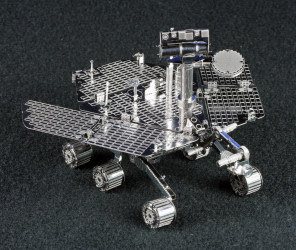
Metal Earth ~1/17 Mars Rover (Spirit/Opportunity) Build Review
By Chuck Holte
| Date of Review | July 2014 | Manufacturer | Metal Earth |
|---|---|---|---|
| Subject | Mars Rover (Spirit/Opportunity) | Scale | ~1/17 (3.5 inch long model, 62 inch long vehicle) |
| Kit Number | - | Primary Media | 3D Laser Cut Steel |
| Pros | Well engineered, unique modeling medium | Cons | None |
| Skill Level | Basic | MSRP (USD) | $10.00 |
Build Review
In early 2004, two small NASA space craft landed safely on opposite sides of the planet Mars. The first was the Rover "Spirit" on 3 Jan and three weeks later, the Rover "Opportunity." Their mission: robotic geology, analysis and imagery, communicating either directly with earth or through Mars orbiters acting as relays. Mission duration was planned for approximately 90 earth days for each rover. Spirit continued to report and respond until March of 2010 and had traveled a total of 7730 Meters (4.8 miles) before going silent. Opportunity (Oppy) continues its Red Planed mission and, as of 1 July 2014, has traveled 24.62 miles. More NASA Mars Exploration Rover information here or here.
Metal Earth market a number of steel construction kits in a surprisingly large and diverse range of subjects, from tiny Farris Wheels to insects to aerospace vehicles. Some are greatly simplified and toy like and others, like the Mars Rover kit, resembles a proper scale model. The Rover kit consists of approximately 75 parts on two laser cut 4.5 inch square sheets of thin steel, much like the familiar sheets of brass PE, only much stronger. Two large 11x16.5 inch instruction sheets provide a well-illustrated, step by step construction sequence and parts map to help carry the project to completion.
Also recommended is their interactive web site showing how all the pieces fit on the finished model http://tinyurl.com/osrtd7a. The instruction recommend a needle nose pliers and a pair of tweezers as tools. I found I needed a strong sprue cutter to separate the bits from the sheet and a pair of smooth jaw hemostats to grip and twist the small metal tabs. Commercial PE bending machines were not needed. Several parts require bending the flat sheet into tubular shapes – I used several sizes, starting with large hobby blade handles, working down to paint brush handles and even toothpicks as mandrels to get the right cross section.
I spent approximately five enjoyable hours constructing my model of the Mars Rover and am well pleased with the result. The finished model is about 3.5 inches long and 3.75 inches wide. I suppose one could paint it, but I rather like the look of the polished steel and left it as is. Highly recommended as another alternate to conventional modeling materials and subjects.















